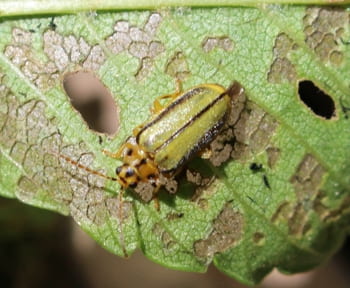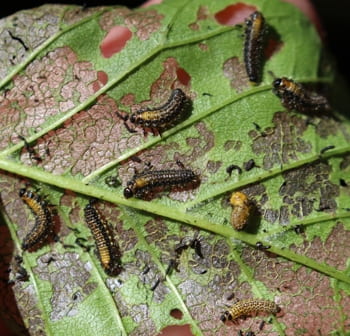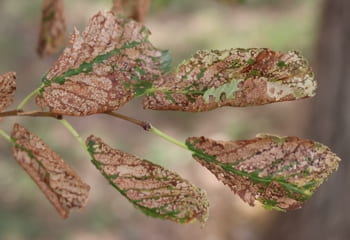–by Raymond Cloyd, Horticultural Entomology
Elm leaf beetle, Pyrrhalta luteola, larvae and adults are prevalent throughout Kansas feeding on elm trees (e.g. Siberian and American). The larvae and adults are typically present simultaneously. Extensive feeding damage can ruin the aesthetic quality of elms in landscapes, parks, and other areas where elms are grown.
Elm leaf beetle adults are 1/5 to 1/4 of an inch long, yellow to dull-green, with a black stripe on each side of the wing cover that extends the entire length of the abdomen (last section). In addition, there are two black spots on both sides of the thorax (middle section) (Figure 1). Adults feed between the major veins, which results in leaves having a ‘shot hole’ (similar to ‘buckshot’) appearance (Figure 2).

Figure 1. Elm leaf beetle adult (Raymond Cloyd, KSU)

Figure 2. Feeding damage associated with elm leaf beetle adults (Raymond Cloyd, KSU)
Elm leaf beetle larvae are 1/3 to 1/2 of an inch long when mature and dull-yellow with two black lines extending the length of the body (Figure 3). The larvae cause the most damage feeding for about three weeks. The larvae feed on the underside of leaves causing the leaves to appear skeletonized and eventually turning brown (Figure 4). The larvae will migrate down the trunk of elm trees and tunnel into or reside on the soil surface to pupate (Figure 5). Adults emerge later on and migrate upward on the tree trunk. In late summer through fall, elm leaf beetle adults will leave elm trees and seek sites to overwinter. Adults overwinter in buildings, homes, and in protected places outdoors such as the bark of elm trees. Adults can be a nuisance pest inside homes when they enter in the fall or leave in the spring. There are two generations per year in Kansas.

Figure 3. Elm leaf beetle larvae feeding on leaf underside (Raymond Cloyd, KSU)

Figure 4. Feeding damage associated with elm leaf beetle larvae (Raymond Cloyd, KSU)

Figure 5. Elm leaf beetle larvae and pupae on the soil surface at the base of an elm tree (Raymond Cloyd, KSU)
A contact insecticide should be applied in spring to manage elm leaf beetle larvae and adult populations feeding on leaves. Thorough coverage of leaf undersides is important because the leaf undersides are where larvae and adults primarily feed. However, if elm trees are exhibiting ≥50% feeding damage then do not spray. Mature elm trees can usually sustain damage associated with elm leaf beetle larvae and adults feeding without direct harm. However, be sure to implement cultural practices such as providing sufficient water and mulching the base of elm trees to ensure that elm trees produce leaves for next year.
Systemic insecticides can be applied to the soil or injected directly into elm trees in early spring before new growth emerges. The systemic insecticide active ingredient will translocate throughout the elm tree and accumulate in the leaves. Elm leaf beetle larvae and adults are killed when they ingest a lethal concentration of the systemic insecticide active ingredient after feeding on leaves.
For more information on how to manage elm leaf beetle populations please refer to the following extension publication:
Elm Leaf Beetle: Insect Pest of Elm Trees (MF3537 July 2020)
https://www.bookstore.ksre.ksu.edu/pubs/MF3537.pdf